|
Postmodern Silly Battle (1999), oil on canvas, 97 x 324 cm, Takahashi Collection. © Yamaguchi Akira, courtesy Mizuma Art Gallery |
The idea of holding a Yamaguchi Akira exhibition at a museum dedicated to horses is nothing short of brilliant. Credit the curators of Yokohama's Equine Museum for this inspired notion, as well as for their excellent execution of the show, which is up until May 29.
Yamaguchi (who requests that his romanized name always appear in Japanese order, surname first) is known for his liberal use of horse motifs, but in extremely curious contexts. Trained in the Edo-period (1603-1867) style of traditional Yamato-e painting, he knows how to draw flawless reproductions of 16th-century battle scenes, which prominently feature samurai on horseback. Yamaguchi has taken the most minute elements of this classical vocabulary and applied (or perverted) them in the service of his own complex vision of contemporary Japan. The results are colorful, lavishly detailed, meticulously rendered paintings that place armored warriors on motorcycles, tiled temple roofs atop streetcars, pagodas on phone poles, geisha houses in department stores. In his New Sights of Tokyo woodblock print series, the iconic Nihonbashi bridge curves triumphantly over the expressway that obscures the present-day span. Other works juxtapose massive suburban shopping malls with old Edo neighborhoods.
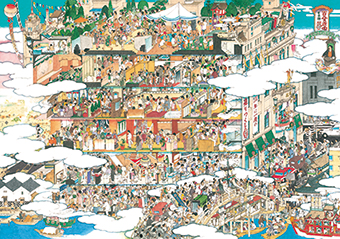 |
|
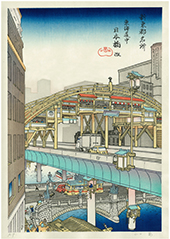 |
|
Department Store: Nihonbashi Mitsukoshi (2004), pen and watercolor on paper, 59.4 x 84.1 cm, collection of Isetan Mitsukoshi Ltd. © Yamaguchi Akira, courtesy Mizuma Art Gallery |
|
New Sights of Tokyo: Tokaido Nihonbashi Revisited (2012), wood engraving, 39.2 x 26.9 cm, Mizuma Art Gallery. © Yamaguchi Akira, courtesy Mizuma Art Gallery |
Such old-subverts-new tropes are nothing novel in contemporary Japanese art -- think hamburger-chomping geishas -- but Yamaguchi takes them several steps beyond satire into the realm of fantasy and science fiction. In these mishmashes of past, present, and future, one of his recurring motifs is the hybrid horse-motorbike. Yamaguchi's samurai not only ride into battle on these half-beast, half-machine creatures; they care for them in stables, repair them in medieval motorcycle shops, and dump them in scrapyards, where the horseheads are devoured by dogs and the bikes are scavenged for their engines and tires.
|
Horse Stable (2001), oil on canvas, 74 x 175 cm, Takahashi Collection. © Yamaguchi Akira, courtesy Mizuma Art Gallery |
|
Horse Stable 2004 (2004), oil and watercolor on canvas, 161 x 303 cm, collection of The Museum of Modern Art, Shiga. © Yamaguchi Akira, courtesy Mizuma Art Gallery |
Perhaps not surprisingly, Yamaguchi's fascination with horses attracted the attention of the Equine Museum, which sits on land in Yokohama that was once Japan's first racetrack. The Negishi Racecourse was built in 1866 for the entertainment of the newly opened port's burgeoning foreign population, but quickly became a popular destination for the citizenry as well, including members of the imperial family. During World War II the Japanese Navy requisitioned the track and its stands, and the U.S. military took over the site when the war ended. Today a large U.S. Navy housing complex still surrounds the former track, which has been converted into a spacious public park. Sitting atop a hill in Yokohama's posh Yamate district, the park commands fine views of the city below, as well as of the long abandoned race-viewing stand, a glorious three-towered relic that still looms over the trees. When the course was returned to the city of Yokohama, the Japan Racing Association decided to build a museum there devoted to the track's history, horseracing, and horses in general. The Equine Museum of Japan opened in 1977.
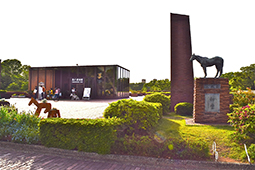 |
|
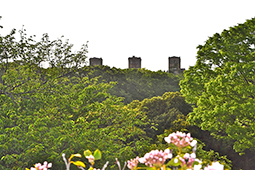 |
|
The Equine Museum of Japan, surrounded by horse statuary and the verdant Negishi Forest Park. Photo by Kaoru Hirose |
|
The majestic remains of the Negishi Racecourse viewing stand, built in 1929, tower over the park. Photo by Kaoru Hirose |
Titled Uma-kagami -- literally "horse-mirror," with "mirror" here connoting something that is a model or paragon of its kind, a "horse among horses" if you will -- the Yamaguchi exhibition is timed to commemorate the museum's 40th anniversary, as well as the 150th anniversary of the opening of the Negishi Racecourse. Yamaguchi's works share the walls with kindred pieces from the museum's own impressive, if thematically selective, collection of horse-related art. This gives viewers a rare chance to see, for example, the artist's horse-bike "stable" scenes alongside the actual Edo-era paintings of stables that he emulated. Fine Yamato-e depictions of samurai in battle formation are on hand, as well as one of the epic early-Edo Rakuchu-rakugai zu (Scenes in and around Kyoto) panoramas of the ancient capital, another source of inspiration for Yamaguchi.
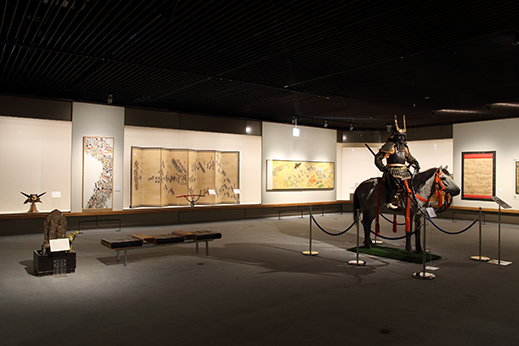 |
|
Installation view. Two works from Yamaguchi's Postmodern Silly Battle series flank a battle formation scene painted in the late Edo period. Photo by Kei Miyajima |
|
Installation view of three "stable" scenes. The screen in the middle was painted in the 16th century; the two on either side are by Yamaguchi. Photo by Kei Miyajima |
|
 |
|
|
|
Horse for Open-Air Tea Ceremony (2008), watercolor on paper, 56.8 x 46.3 cm
© Yamaguchi Akira, courtesy Mizuma Art Gallery
|
Scattered throughout the main gallery are other items of relevance -- a life-size armored samurai on horseback, centuries-old helmets (boasting designs no less bizarre than Yamaguchi's), a horse skull, a mockup of an actual horse stable. Also worth a look are the museum's permanent exhibits on the evolution of the horse, equine culture in East Asia, and of course the racetrack -- a fascinating East-meets-West story in its own right. Horse lovers may wish to round out their day with a visit to the adjacent Pony Center and riding ground. Whether or not you care much for horses, however, the Equine Museum, the Yamaguchi show, and the surrounding park offer a full oatbag's worth of entertainment, and much food for thought to munch on.
From Horse Car (2015), oil and sumi (Japanese ink) on canvas, 60.6 x 72.7 cm, private collection. © Yamaguchi Akira, courtesy Mizuma Art Gallery |
|
Models of a horse stable interior and exterior at the Equine Museum. Photo by Kei Miyajima |
All images are courtesy of the Equine Museum of Japan.
|
 |
|
| |
1-3 Negishidai, Naka-ku, Yokohama
Phone: 045-662-7581
Hours: 10 a.m. to 4:30 p.m. (final entry 4 p.m.); closed Mondays (except holidays)
Access: 15 minutes' walk uphill from Yamate Station on the JR Keihin-Tohoku Line (9 minutes south of Yokohama Station). Or take city bus no. 21 from either Sakuragicho or Negishi on the same line and get off at Takinoue. |
|
|
| |
 |
Alan Gleason
Alan Gleason is a translator, editor and writer based in Tokyo, where he has lived for 30 years. In addition to writing about the Japanese art scene he has edited and translated works on Japanese theater (from kabuki to the avant-garde) and music (both traditional and contemporary). |
|
|
|
|